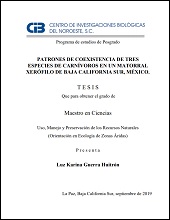Mostrar el registro sencillo del ítem
PATRONES DE COEXISTENCIA DE TRES ESPECIES DE CARNÍVOROS EN UN MATORRAL XERÓFILO DE BAJA CALIFORNIA SUR, MÉXICO
| dc.contributor.advisor | ARNAUD FRANCO, GUSTAVO ALBERTO | |
| dc.contributor.advisor | Blázquez Moreno, María del Cármen | |
| dc.contributor.author | GUERRA HUITRON, LUZ KARINA | |
| dc.date.issued | 2019 | |
| dc.identifier | https://cibnor.repositorioinstitucional.mx/jspui/handle/1001/1683 | |
| dc.identifier.uri | http://dspace.cibnor.mx:8080/handle/123456789/2992 | |
| dc.description.abstract | "En la comunidad de vertebrados terrestres del matorral xerófilo, conviven tres especies de carnívoros con semejanzas morfológicas, fisiológicas y comportamentales: el gato montés (Lynx rufus), el coyote (Canis latrans) y el zorro gris (Urocyon cinereoargenteus). Se propuso dilucidar los factores que permiten la co-existencia de las tres especies en una misma zona, en el área de Comitán-Zacatecas en el sur de la península de Baja California. La hipótesis planteada fue que, dada la simpatría, se esperaba encontrar segregación a nivel de nicho trófico, espacial o temporal. La dieta fue evaluada a través del análisis de sus excrementos, de febrero a noviembre de 2017. Los excrementos de coyote fueron los más abundantes y los del zorro las que menos. Las tres dietas resultaron muy similares. Se presentaron altos porcentajes de mamíferos, vegetales e invertebrados. La similitud osciló entre Ojk= 0.55 - 0.71, siendo más parecidas las de coyote y gato montés, después de las lluvias. El alto porcentaje de invertebrados en la dieta de los zorros, la diferenció de las otras. El nicho espacial y temporal se evaluaron con fototrampeo, además de estaciones olfativas para nicho espacial. Se encontró diferencia en las abundancias, siendo el gato la especie más registrada y el zorro la que menos (139:40:22). Las tres especies prefirieron los cauces secos de arroyo a la zona de planicie, pero usaron el área de forma distinta y el translape espacial fue baja oscilando entre gato montés y zorro (Ojk=0.18 - 0.35); para gato montés y coyote (Ojk= 0.01-0.14). Las estaciones olfativas fueron más efectivas para detectar a zorro gris. Se encontraron coincidencias en las horas de actividad entre las tres especies, todas prefirieron el horario nocturno entre 20:00 y 00:00 hrs, aunque los cánidos también fueron activos antes del amanecer en la temporada de lluvia. En el análisis de translape de nicho temporal (por hora) el coyote y gato montés tuvieron el valor más alto tanto para temporada seca (Ojk= 0.85), como para temporada de lluvia (Ojk= 0.53). Como resultado, se obtuvo un patrón de coexistencia dinámico, en el que las tres especies evitan la competencia, variando la alimentación, el uso del microhábitat y también las horas de actividad en las diferentes temporadas del año." | es |
| dc.format | es | |
| dc.language.iso | spa | es |
| dc.publisher | Centro de Investigaciones Biológicas del Noroeste, S.C. | es |
| dc.rights | Acceso abierto | es |
| dc.subject | nicho trófico, nicho espacial, nicho temporal, carnívoro, segregación | es |
| dc.subject | rophic, niche, spatial niche, temporal niche, carnivore, segregation | es |
| dc.subject.classification | VERTEBRADOS | es |
| dc.title | PATRONES DE COEXISTENCIA DE TRES ESPECIES DE CARNÍVOROS EN UN MATORRAL XERÓFILO DE BAJA CALIFORNIA SUR, MÉXICO | es |
| dc.type | masterThesis | es |
| dc.dirtesis.grado | Maestría en Ciencias en el Uso, Manejo y Preservación de los Recursos Naturales | es |
| dc.dirtesis.disciplina | Ecología de Zonas Áridas | es |
| dc.dirtesis.universidad | Centro de Investigaciones Biológicas del Noroeste, S.C. | es |
| dc.dirtesis.facultad | Posgrado en Recursos Naturales | es |
| dc.description.abstracten | "In the community of terrestrial vertebrates of the xerophilous scrub, three species of carnivores coexist with morphological, physiological and behavioral similarities: the bobcat (Lynx rufus), the coyote (Canis latrans) and the gray fox (Urocyon cinereoargenteus). It was proposed to elucidate the factors that allow the co-existence of the three species in the same zone, the Comitán-Zacatecas area, in the south of the Baja California peninsula. The hypothesis was that, given the sympatry, it was expected to find segregation at the trophic, spatial or temporal niche level. The diet was evaluated through the analysis of their excrement, from February to November 2017. Coyote excrement were the most abundant, and those of the fox were the least. The three diets were very similar. There were high percentages of mammals, plants and invertebrates. The similarities ranged between Ojk = 0.55 and 0.71, with coyote and bobcat being more similar, after the rains. The high percentage of invertebrates in the diet of the fox differentiated it from the others. The space and temporal niche were evaluated with camera traps, in addition to scent-stations for space niche. Difference in abundance was found, with the bobcat being the most recorded species and the fox being the least (139: 40: 22). The three species preferred the dry stream beds to the plains zone, but used the area differently and the spatial overlap was low ranging between bobcat and fox (Ojk = 0.18 and 0.35); for bobcat and coyote (Ojk=0.01-0.14). Scent-stations were more effective in detecting gray foxes. Coincidences were found in the hours of activity between the three species, all preferred the nighttime between 20:00 and 00:00 hrs, although the canids were also active before dawn in the rainy season. In the analysis of temporal niche overlap (by hour) the coyote and bobcat had the higher value for dry season (Ojk= 0.85), and rainy season (Ojk= 0.53). As a result, a dynamic coexistence pattern was obtained, in which the three species avoid competition, changing the food, the use of the microhabitat, and also the hours of activity in the different seasons of the year." | es |

